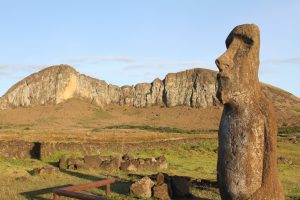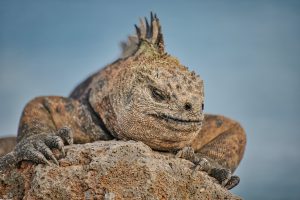82 Latin America and the Caribbean (LACAR): Political Geography III – South American Islands
Although the continent of South America is a relatively compact shape and not a substantially insular region (compared to Europe or Southeast Asia), there are several noteworthy islands that belong to South American countries. Intriguingly, several of these islands are very remote from the mainland.
Easter Island is renowned for the large stone statues – moai – that were carved by native peoples on the island between 1200 and 1500 CE. The native Rapa Nui reached the island as part of the Austronesian Expansion that is addressed in Chapter 15. Genetic evidence also shows mixing of populations from South America and Polynesia.

Apparently, Rapa Nui sailed to and from Easter Island and the mainland, even bringing people from the mainland home with them. European explorers arrived at the island on Easter Sunday in 1722, thus bestowing the island’s modern name to it. Chile annexed the island in 1888. Easter Island is one of the most isolated places in the world. It is nearly 1300 miles to the nearest inhabited island – Pitcairn Island, population roughly fifty people. As seen in this map, Easter Island is vastly separated from just about anywhere.

Ecuador is famous for its Galapagos Islands, where Charles Darwin studied wildlife in 1835 while developing his theory of evolution. These islands are in the Pacific Ocean over 550 miles west of Ecuador. Tourists enjoy the distinctiveness of the islands; however, natural preservation is crucial. UNESCO has designated the location as a World Heritage Site and a biosphere reserve. The islands were discovered in 1535 on a chance observation during a voyage from Panama to Peru.

Fernando de Noronha is Brazil’s volcanic archipelago. Located in the Atlantic Ocean, about 270 miles east of the mainland, the islands were discovered by Portuguese sailors, though the initial discovery is disputed, perhaps 1501 or 1502 or 1503. It too is a World Heritage Site. It is a visually stunning location, a exciting tourist destination; however, while tourism is important to the local economy, the number of tourists allowed has a daily limit in order to preserve the natural setting.
Having coastline on both the Pacific Ocean and the Caribbean Sea, Colombia naturally has islands in both waters. Its Rosario Islands (Islas del Rosario) comprise a natural park designated to preserve Caribbean coral reefs. Tourists are allowed at the park; indeed, the islands are only 62 miles from the Colombian port city of Cartagena.

Argentina lays claim to the Falkland Islands (and to South Georgia and the South Sandwich Islands too), though the islands have been under British control since 1834, except for several weeks of occupation by Argentinian military forces in 1982. The Islas Malvinas, as known in Argentina, are 184 miles from the mainland, but of course are a vast distance from the England. Clearly, it is another example of the vast British Empire.
The former French penal colony known as Devil’s Island stood on the Salvation Islands of French Guiana, about seven miles off the coast. Conditions at the facility were abysmal; prisoners often suffered from poor sanitation, risk of tropical disease, and brutal violence. The location gained fame from the 1969 novel and 1973 film Papillon, a probably exaggerated memoir of escapee Henri Charrière. There have been numerous film and literary references to the location. The prison camp was closed in 1953.
The countries of Guyana, Uruguay, Suriname have small stretches of coastline and lack noteworthy islands. Both Venezuela and Peru have lengthier coastlines, but also feature few islands of importance. Both Bolivia and Paraguay are landlocked, obviously having no island territories.
Did You Know?
China supports Argentina’s claim to the Falkland Islands (Islas Malvinas), while Argentina backs China’s assertion that Taiwan is an integral part of China. Meanwhile, Taiwan agrees that the Falkland Islands belong in the United Kingdom, while the UK supports Taiwan’s claims of independence from China.
The 1973 film Papillon was a box office success, featuring stars Dustin Hoffman and Steve McQueen, but the 2017 reboot generally was considered a mediocre remake.
Cited and additional bibliography:
Dunham, Will. 2014. “Easter Island’s Ancient Inhabitants Weren’t so Isolated after All.” Washington Post, October 27, 2014, sec. Health & Science. https://www.washingtonpost.com/national/health-science/easter-islands-ancient-inhabitants-werent-so-isolated-after-all/2014/10/27/6cc436ce-5af2-11e4-8264-deed989ae9a2_story.html.
Muruci, Eduardo. 2011. Cachorro Beach. https://en.wikipedia.org/wiki/Fernando_de_Noronha#/media/File:EDUARDO_MURUCI_-_PRAIA_DO_CACHORRO.jpg. By Eduardo Muruci – Own work, CC BY-SA 3.0, https://commons.wikimedia.org/w/index.php?curid=33120896.
Woodman, Stephen. 2018. “Welcome to the 11 Most Remote Islands in the World.” Culture Trip. The Culture Trip. January 18, 2018. https://theculturetrip.com/north-america/mexico/articles/welcome-to-the-11-most-remote-islands-in-the-world/


